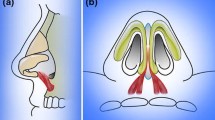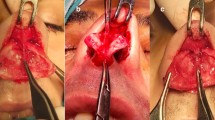Abstract
Background
The depressor septi nasi (DSN) muscle is an important muscle in nose dynamics. Its hyperactivity causes smile deformity including nasal tip depression. The nasal tip of individuals with a hyperactive DSN muscle depresses repeatedly while they are speaking and smiling. This may result in nasal lengthening as they age.
Methods
Pairs of cases consisting of a child and one of his or her parents were studied in two groups: case group (with DSN muscle hyperactivity) and the control group (with DSN muscle inactivity in both child and parent). Nasal length from nasion to tip and facial length from nasion to menton were measured during repose and during smiling.
Results
This study investigated 80 pairs of children and parents. In both groups, a significant linear correlation between the nasal length of the parent and the child was found. In both groups (case and control), the nasal length of the child differed significantly from that of the parent. The increase in the nasal length of the parents compared with the children was greater in the control group.
Conclusions
This study demonstrated that nasal length increases with age and that DSN muscle hyperactivity is not an effective factor in this increase. This unpredictable result may affect the presumption that patients with DSN muscle hyperactivity will have longer noses in the future. Long-term prospective studies investigating cohort groups are required to clarify the variables affecting nasal lengthening with aging, and interventional studies are needed to examine the effects of DSN muscle resection on this phenomenon.
Level of Evidence III
This journal requires that authors assign a level of evidence to each article. For a full description of these Evidence-Based Medicine ratings, please refer to the Table of Contents or the online Instructions to Authors www.springer.com/00266.



Similar content being viewed by others
References
Rohrich RJ, Huynh B, Muzaffar AR, Adams WP Jr, Robinson JB Jr (2000) Importance of the depressor septi nasi muscle in rhinoplasty: anatomic study and clinical application. Plast Reconstr Surg 105:384–388
de Souza Pinto EB (2003) Relationship between tip nasal muscles and the short upper lip. Aesthet Plast Surg 27:381–387
Ebrahimi A, Nejadsarvari N, Motamedi MH, Rezaee M, Koushki ES (2012) Anatomic variations found on dissection of depressor septi nasi muscles in cadavers. Arch Facial Plast Surg 14:31–33
Figallo E (1995) The nasal tip: a new dynamic structure. Plast Reconstr Surg 95:1178–1184
Cachay-Velasquez H (1992) Rhinoplasty and facial expression. Ann Plast Surg 28:427–433
Arregui JS, Elejalde MV, Regalado J, Ezquerra F, Berrazueta M (2000) Dynamic rhinoplasty for the plunging nasal tip: functional unity of the inferior third of the nose. Plast Reconstr Surg 106:1624–1629
Figallo EE, Acosta JA (2001) Nose muscular dynamics: the tip trigonum. Plast Reconstr Surg 108:1118–1126
Mahe E, Camblin J (1975) Resection of the depressor muscle of the tip in esthetic rhinoplasties. Ann Otolaryngol Chir Cervicofac 92:381–387
Hwang K, Kim DJ, Hwang G (2006) Relationship between depressor septi nasi muscle and dermocartilagenous ligament: anatomic study and clinical application. J Craniofac Surg 17:286–290
Tellioglu AT, Inozu E, Ozakpinar R, Eryilmaz T, Esmer AF, Sen T, Tekdemir I (2012) Treatment of hyperdynamic nasal tip ptosis in open rhinoplasty: using the anatomic relationship between the depressor septi nasi muscle and the dermocartilaginous ligament. Aesthet Plast Surg 36:819–826
Gamboa M, Shayani P, Schmid R, Bobadilla E, Blackwell S (2003) Anatomic basis of notch deformity in open rhinoplasty. Ann Plast Surg 50:285
Ohtsuka H (2005) Hypertrophy of the depressor septi nasi muscle. Plast Reconstr Surg 116:1817
Hormozi AK, Toosi AB (2008) Rhinometry: an important clinical index for evaluation of the nose before and after rhinoplasty. Aesthetic Plast Surg 32:286–293
Acknowledgments
The results described in this study formed part of a thesis submitted by the fourth author for a postgraduate degree in general surgery. The study was supported by the Vice Chancellor of Research of Mashhad University of Medical Sciences.
Author information
Authors and Affiliations
Corresponding author
Rights and permissions
About this article
Cite this article
Beiraghi-Toosi, A., Rezaei, E., Jabbari Nooghabi, M. et al. Effect of Depressor Septi Nasi Muscle Activity on Nasal Lengthening With Time. Aesth Plast Surg 37, 984–988 (2013). https://doi.org/10.1007/s00266-013-0137-x
Received:
Accepted:
Published:
Issue Date:
DOI: https://doi.org/10.1007/s00266-013-0137-x




